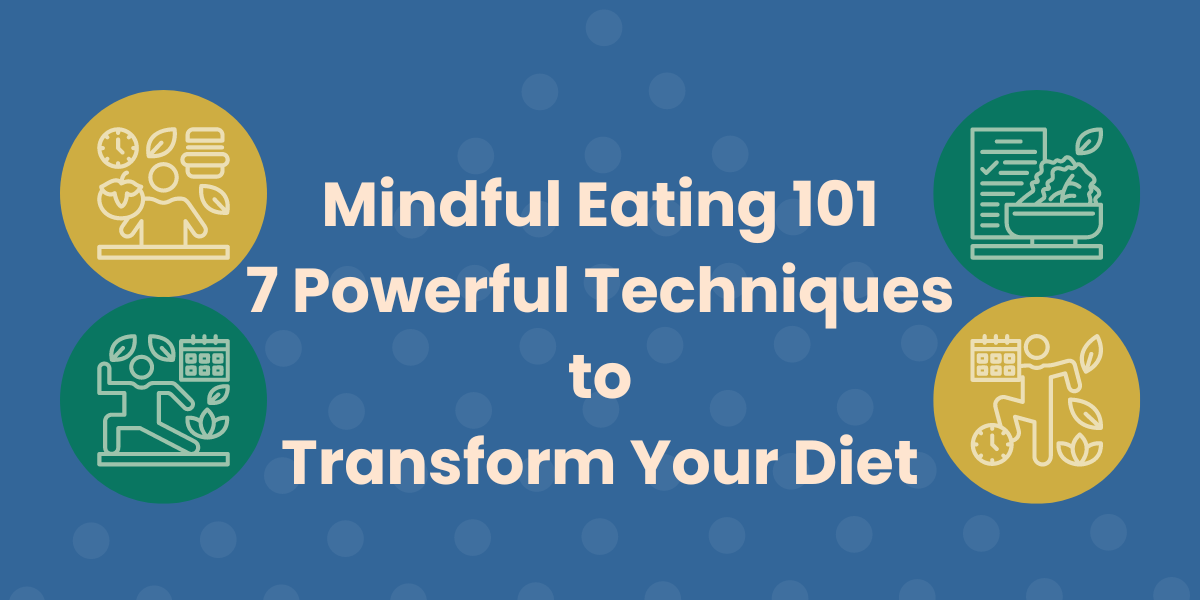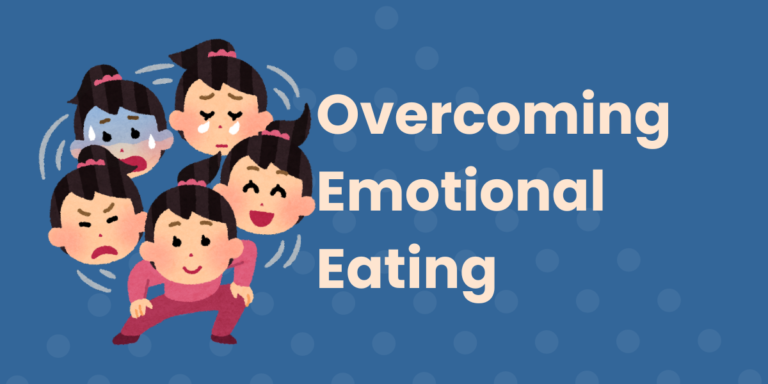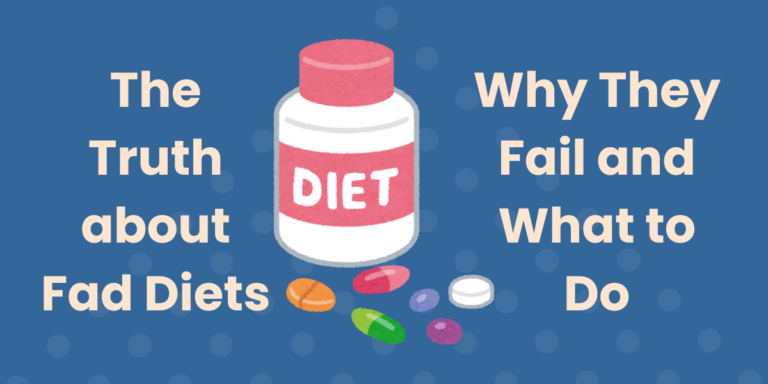Mindful Eating Techniques 101: 7 Powerful Ways to Transform Your Diet
“As your assignment for this week’s mindful practice, I want you to be more aware of the food you eat. Take your time to pay attention to the sights, smells, taste, and feel of every bite.”
I had joined a meditation group in medical school where the school psychologist guided our weekly practice.
This would be my first experience with mindful eating techniques. I imagine many people have similar notions of what this practice entails.
Considering that we make over 200 food-related decisions every day1 (I had no clue there were that many), I thought slowing down made sense. After all, how many of us truly pay attention to what we’re eating?
Welcome to Mindful Eating 101!
In this guide, we’ll explore powerful techniques to transform your relationship with food.
Get ready to embark on a journey that’ll change the way you experience every bite. Trust me, your taste buds (and waistline) will thank you!
What is Mindful Eating and Why Does it Matter?
Many people think that mindful eating looks a lot like what I described above. Slow down, take your time, really savor every sensation.
Definition of mindful eating – A shift in perspective
While I enjoyed that exercise and found it very informative, I eventually realized that the practice was meant to bring a higher awareness of the dance between the food and the self. At some point, the distinction dissolves and you dance as one.
After all, the ultimate goal is to consume food for integration into one body.
Benefits of practicing mindful eating
Yes, there are medical benefits. Yes, mindful eating can help you lose weight. Yes, this practice could help with diabetes and blood pressure. There are many studies that can demonstrate these advantages.
That’s not why we’re here.
The benefits revolve around why you choose to practice; and why you choose to practice depends on your values.
Ultimately, mindful eating is a practice of further aligning with your values.
To find out why you might benefit from this practice, ask yourself these questions:
- Why are you exploring mindful eating practices?
- If there were just three rules that MUST be followed, what would they be?
- How would this practice enrich your life?
- What do you stand for? Tell me why that is so special to you?
- How does mindful eating fit into your vision of who you are?
These are just some questions we can explore. The benefit of any action tends to a core value that needs attention.
Identify and nurture it.
The science behind mindfulness and its impact on eating habits
Mindfulness seems to demonstrate greater self-control over food decisions.
Although mindfulness may help you lose weight, losing weight is not the primary benefit. According to mindful eating research, the primary benefit is greater self-control and making conscious food choices.2
To my mind, removing the goal of weight loss frees you to make more holistic decisions that are better for you in the long run.
Common misconceptions about mindful eating
- Mindful eating is a diet – Wrong.
- Mindful eating is not a diet.
- It begins with what you currently consume.
- Two common ways people already practice mindful eating without knowing it:
- Chewing 24 times before swallowing.
- Taking a little more time to savor a delicious bite.
- It’s easier than a diet – Wrong.
- First of all, it’s not a diet.
- Conscious eating habits are not easy or difficult. You simply practice awareness.
- It takes too long – Wrong.
- Mindfully enjoying food does not take long at all. It requires you to shift your awareness.
- Practice does not take long either. However, practice over time helps enhance your skills and experience.
- You will go hungry – Wrong.
- This is not a restrictive diet. There are no calories to count or a minimum requirement.
- You simply pay more attention to what you eat. You open yourself up to the sensory input and allow that information to percolate to consciousness.
- I’ll turn into Kung Fu Panda and only survive on “universe juice” – Wrong.
- This was my personal fear.
- Panda didn’t need to focus on his diet in order to master his qi.
- This is not the goal.
- The goal is the practice of awareness.
- Therefore, if you practice being more aware, then you’ve already achieved your goals. All that’s left is to keep practicing.
- The practice is a system. The system resolves all goals when put into consistent action.
Mindful eating begins and ends with the self. The most important benefit from practice is to become more aligned with your values through greater awareness.
So where do we start?
With the breath.
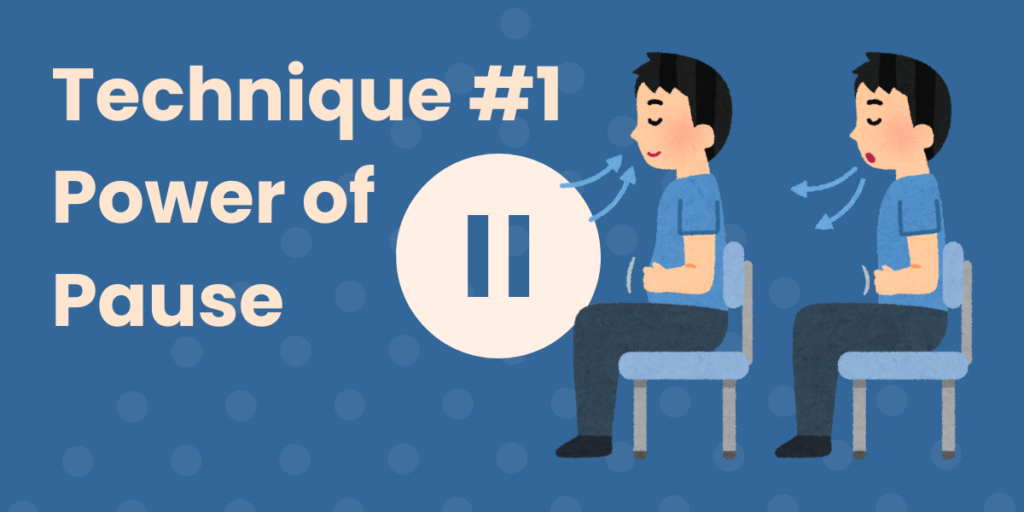
Technique #1: The Power of Pause – Breathing Before Biting
In my Qigong practice, the breath is the center; figuratively and literally. Ironically, the air we breathe grounds our thoughts and actions. Let’s see why this is important.
Importance of taking a moment before eating
Imagine pulling up to a drive thru. The buzzy voice crackles through the speaker, kssh, “Can I take your order?”
“Yes, I’d like two filet mignon combo meals with a bottle of your ’58 vintage to drink.”
Kssh, “Would you like fries with that?”
“No, thank you.”
Kssh, “Alright that’ll be $375.23. Please pull up to the next window.”
What’s wrong with this picture? Does ANYBODY order fine-dining items through a drive thru window?
No.
And why not?
Because this food is designed for a sumptuous evening. Certainly not to be scarfed down to tame a growling stomach while we run to our next meeting or hurry home with dinner for the kids.
Instead, we take a series of little moments throughout the evening which culminate in the experience of food. Then we slowly appreciate every bite with good company.
The power of pausing and taking a breath before every bite can elevate fast food into a fine-dining experience.
There is obviously a difference in the quality from a fast food joint and a Michelin star restaurant. However the main idea is to start with the breath.
Let the breath lead you into whatever you will experience.
How to practice pre-meal breathing exercises
I’m not a guru with secret and mystical knowledge. I’m not a medical doctor with evidence-based step-wise guidelines. There is no special technique.
Take a breath before you bite.
Literally ANYBODY can do this right now.
You don’t even have to sit down to a proper meal. Do this with a snack or with your coffee. The main purpose is to practice mindfulness through the breath.
As you practice, something really cool happens.
Benefits of pausing before meals
- You take on a curiosity-based mindset and want to explore food.
- Naturally make better food choices.
- Food has more flavor than you realized.
- Emotions and memories arise, yet they do not cause emotional eating.
- You are in control.
These are the benefits I’ve noticed. It all starts with the breath.
How can you practice taking a breath?
Tips for incorporating this technique into daily life
Whenever I try to form a new habit, I have one BIG problem: I forget.
The same problem with any new habit I’m trying to form.
There are 2 reasons I forget:
- Procrastination: If it seems too hard, then I don’t start. Just start. You will figure it out.
- Set a reminder: I forget a lot of things. So I set an alarm on my phone.
If you take away nothing else, then simply pause.
Technique #2: Engage Your Senses – The Art of Food Appreciation
Food is an art form which envelopes you with inviting aromas, striking visuals, sizzling and crackling harmonics, mouth-watering flavors, and wonderful textures!
Using all five senses while eating
People already know that when the meat hits the grill with a good sizzle, it’s gonna be good!
Or when you feel the crackle and see the puff of steam as you cut through a fresh loaf of bread, you know you’ll be in heaven soon!
We already use all five senses while eating. Here are my questions for you:
- Why do you appreciate art?
- Why not just look at pictures of delicious food while simply swallowing nutrient-rich capsules?
- Is the purpose of food strictly to nourish the body?
- What makes food a human experience?
- What makes this human experience uniquely your own?
Your senses help you appreciate the beauty of the world. What is beautiful?
Your rich inner world. Your senses simply allow you to appreciate your expression into the world.
Steps to fully experience the taste, smell, and texture of food
Trying to fully experience every sense can be overwhelming. Five senses don’t seem like much until you try to use them all at the same time!
I tried to focus on one sense per meal. I started with the sense of taste since it made sense (see what I did there?). Feel free to start wherever you like.
- Sit, pause, and take a breath. (Technique #1)
- Look: Observe the colors, shapes, and arrangement of your food.
- Smell: Take a moment to inhale the aroma before tasting. (You may notice this with your initial breath)
- Touch: Notice the temperature and texture as you pick up your utensils or the food on your lips or in your mouth.
- Listen: Pay attention to the sounds as you chew or cut your food.
- Taste: Focus on the flavors, noticing how they change as you chew. (In gradeschool, I discovered that bread was actually simple sugars when the teacher instructed the class to chew the bread slowly)
How sensory engagement enhances satisfaction and reduces overeating
Would you like to have higher meal satisfaction? What would that mean to you?
How about feeling more content with smaller portions?
Would better intuition of identifying true hunger and fullness cues fit into your self vision?
Enhancing the overall eating experience makes meals more enjoyable.
Fun exercises to practice sensory awareness with food
- Blindfolded taste test: Try identifying foods based on smell and taste alone.
- Texture challenge: Explore foods with various textures in one meal.
- Color palette meal: Create a plate with foods of different colors and describe each.
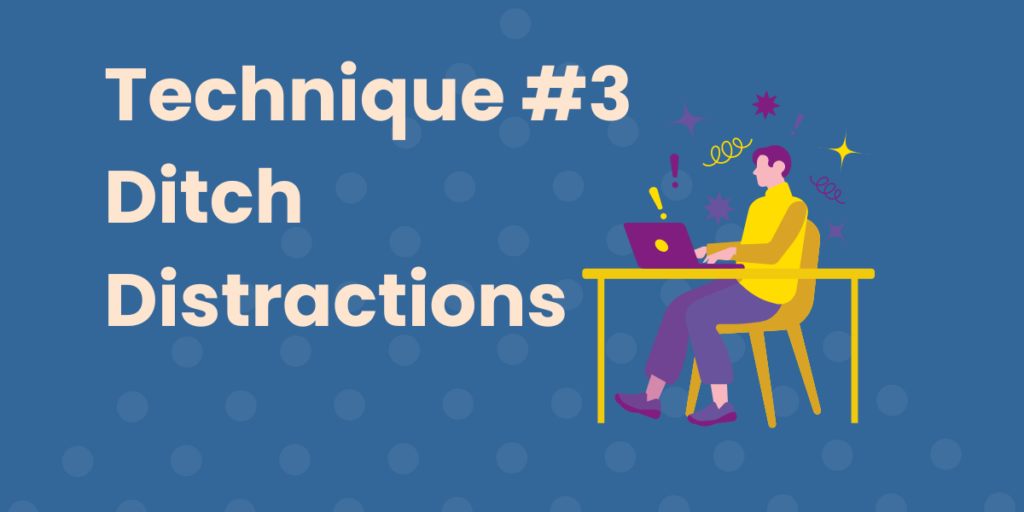
Technique #3: Ditch the Distractions – Focused Eating for Better Digestion
As a society, we like to blame technological advancements for stealing our attention. However, we get distracted by more than television and our phone.
We get distracted with worry, with frustrations, with disappointments of life. So we turn to technology to “quiet” our mind so that we can have a “peaceful” meal.
How do we have a peaceful meal without the need for distractions?
Identifying common mealtime distractions
It’s not hard to figure this one out. What’s the first thing you flip on? Chances are that it has a screen. However, I want you to look a little deeper than a glass surface.
- Tell me why you have chosen to focus on something other than your meal?
- What would happen if you turned off the screens?
- Can you tell me more about the thoughts that surface on the screen of your mind?
- Tell me about the feelings and emotions associated with those thoughts.
Why do we consider these questions?
Benefits of eating without screens or multitasking
- You enjoy your food.
- You enjoy your company.
- You are more attuned to your emotions.
- You satisfy the hunger of your body and your soul’s desire for connection with self and others.
- You allow yourself to unwind.
The process of unwinding starts fast then slows down like a spring.
This gets in the way of the meal and potentially leads to emotional eating.
So what do we do?
Pause. Take a breath.
Remember, mindful eating begins before the meal.
Strategies for creating a distraction-free eating environment
You’ve heard it all before: Turn off the TV; Don’t bring your phone to the table; etcetera.
That’s fine. Here’s what I do: I spend at least half an hour journaling or walking or riding my stationary bike or staring at the ceiling BEFORE my dinner.
I don’t listen to music or podcasts; I don’t watch videos; I don’t read text messages during this time. This time is protected. Why?
Here begins emotional processing. This is the time I let my mind unwind from all the craziness of the day. This is the time I allow my brain to process every piece of shenanigans I’ve experienced. Then my brain can decide to keep what’s valuable and purge the rest.
In a sense, my mind must mentally digest what my senses have consumed, integrate what is beneficial, and eliminate what is toxic.
Now, we may eat in peace. No external or internal distractions. A truly distraction-free environment.
There may still be things to talk about over dinner. At least I can speak from a better head space.
How focused eating improves digestion and nutrient absorption
This sounds ridiculous! How can focusing on what you eat improve digestion and nutrient absorption? It’s not like people have the superpower of teledigestive ability.
True, but people have the superpower of self-awareness. What happens with greater self-awareness? Two things:
- You naturally pay attention to what goes into your body.
- Therefore you naturally begin to select wholesome foods.
- Greater nourishment.
- Cleaner energy.
- Easier digestion.
- You begin to minimize “junk” foods.
- Make more space for the foods that help you feel well.
- Get rid of excess calories.
- Therefore you naturally begin to select wholesome foods.
- You stop eating when you feel full.
- Therefore the tank is not overcrowded.
- An optimally full tank leads to better breakdown of food.
- This also leads to better nutrient absorption.
So work to develop a focus. Don’t know how?
Try the next technique.
Technique #4: Slow Down and Savor – The 20-Minute Meal Challenge
My Qigong practice emphasizes slow movements to enhance awareness of feeling within the body.
Similarly, slowing down can help you savor food.
Many times we’re hungry and we just have to get food in our stomachs to move on to the next task.
Why should you care to slow down when you don’t have the time?
Why eating slowly is crucial for mindful eating
You don’t have to lift a fork at the pace of a snail to eat escargot.
However, mindful eating requires your attention.
There is so much vying for our attention that we easily forget how to put things down mentally.
Therefore eating slowly gives us time to recalibrate our attention and focus on the present.
The 20-minute meal challenge explained
Many people have caught wind of this idea:
It takes about 20 minutes for your stomach to tell your brain that it is full.
Well… Not exactly.
The brain gauges fullness by two methods:
- Nerve transmission – Fast Signal
- As you eat, the stomach stretches.
- As your stomach stretches, nerves detect that stretch and get triggered.
- The strength of the signal is determined by the amount of stretch.
- The greater the stretch, the stronger the signal to the brain.
- Until you finally feel “full”; which is really the level of stretching you comfortably judge as “full”.
- Hormone transmission – Slow Signal
- A variety of hormones play a role in the feeling of fullness.
- GLP-1 agonists (a popular weight loss injection usually taken once weekly) help people lose weight by providing an artificial signal.
- This makes people feel less hungry and less frequently.
- Therefore they eat less.
- This is just one hormone in an orchestra of hormones involved.
The idea of the 20-minute challenge is to give your body enough time to process all these signals. Otherwise you might overeat in those 20 minutes.
Is our nature flawed? Why is our system set up this way?
There is a self-preservation mechanism here.
In a day when calorie-rich foods were not easily accessible, you had to eat as much as possible when you find food. However, you don’t want to eat so much that you cannot run from a lion when necessary.
In essence, we have a biological timer that tracks how much we eat. So we take in enough nourishment without becoming nourishment for something else.
Today we live in a world with more calorie-dense food items instead of nutrient-dense foods.
So overeating is easier than ever because:
- Higher availability – Which means high-calorie foods are abundant in the market.
- Easily accessible – Which means you can get it anytime you want.
1 + 2 = increased likelihood of unconscious weight gain.
Therefore we are forced to pay more attention to what we eat.
So how can we slow down before things get out of hand?
Tips for slowing down your eating pace
If time is of the essence, use technique #1:
Pause and take a breath.
At the very least, this strategy uses time to your advantage.
Technique #3: Eliminate distractions.
When I’m distracted, time does not exist. Everything just seems to blend together without conscious thoughts or attention.
Television programs must be designed to keep you entranced for your viewership. Even commercials have become more ludicrous in the battle for your attention.
Turn it off. Put your phone away. Take a note from the Europeans and sit with your family. Enjoy a nice conversation over good food.
Pro-tip: The conversation helps you pause and breathe between bites without any conscious effort on your part.
How slower eating affects satiety and portion control
Slower eating lets your fast and slow signals converge in your brain’s satiety centers; culminating in the sensation of fullness.
You won’t feel full faster if you eat more. 20 minutes is 20 minutes no matter what you do with them.
However, taking more time to savor your meal and good company helps with portion control.
More importantly, it helps improve attunement to your cues of hunger.
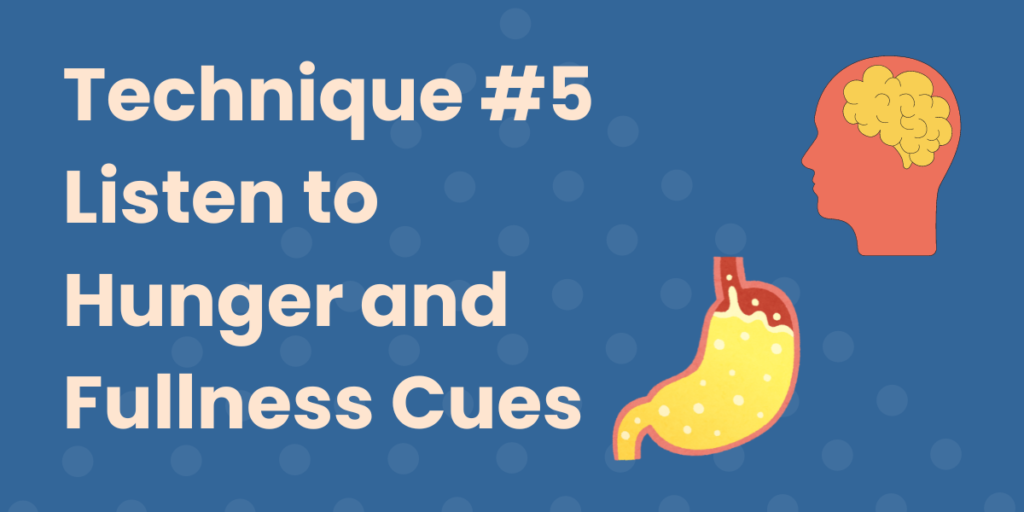
Technique #5: Listen to Your Body – Hunger and Fullness Cues
We eat when we’re hungry, and stop when we’re not. Simple… right?
Well… not really.
Our world is full of worry, anger, excitement, and delight. Emotions are the spice of life!
While emotions may allow us to appreciate and savor our food, we must be mindful not to let emotions be the spice of food.
How?
Understanding physical hunger vs. emotional hunger
Physical hunger is a complicated physiological process. This process serves to nourish and energize the body. When we lack energy or nutrients, we receive hunger signals to find the food we need to support our bodies.
However, what if we can undermine this intricate mechanism? Is it possible?
Emotional hunger is a phenomenon that can enhance the enjoyment of food or lead to long-term health consequences.
How do we maintain a rich and positive experience without succumbing to emotional eating?
How to recognize and interpret body signals
What do emotions, hormones, hunger, thirst, and sex drive all have in common?
Answer: The hypothalamus.
The hypothalamus is a small area of the brain that regulates all these body functions (and more). So the hypothalamus acts as a hub for all this information.
Therefore, emotions can easily influence hunger levels. This is very useful on an evolutionary basis for survival.
Fear will shut down your digestive system and make you run from that lion!
Conversely, feeling warmth and closeness with your significant other may inspire a romantic night to share a sumptuous meal and use that energy to procreate!
As you can see, emotions enrich our experience of food. We must simply practice awareness to interpret the body’s signals properly. Otherwise we may find ourselves eating a pint of ice cream every night rather than just after a bad break-up.
So where do we begin our awareness?
Pause… take a breath… now continue.
The hunger-fullness scale and how to use it
You’ve probably heard of the hunger-fullness scale. It’s a clever idea to begin developing awareness of hunger cues.
Basically, the scale ranges from 1 to 10. 1 means you are so hungry that you actually feel weak. 10 means that you are so stuffed that the mere thought of food makes you feel sick. (If you don’t know how these extremes are possible, go to a buffet. You’ll find out.)
I’ve noticed that people seem stuck on exact numbers to decide when and how much to eat.
No need.
The goal is not a number. The goal is the practice of developing greater self-awareness. You will subconsciously make the best adjustments for you.
Feel free to go up and down the scale as much as you desire; just pay attention to where you are on that scale.
The more you become aware, the more you tune into your body’s needs.
Technique #6: Mindful Food Choices – Nourishment Over Restriction
Diets have never made sense to me.
Granted, I understood that they can help you reach your weight loss goals. However, I would prefer diets that are focused on nutrition.
So how do we shift perspective from restrictive diets to nutritious ones?
Shifting from diet mentality to nourishment focus
What is a diet?
In essence, a diet is everything you ingest.
A diet is not:
- Something to go on.
- A bandwagon to fall off.
- A program to sign up for.
- A crash.
- A yo-yo.
- Intermittent
- Keto
- Paleo
- Vegetarian
- Mediterranean
- Carnivore
- Fill in the blank.
What is a diet?
My definition is simple:
A diet is what you eat and/or drink to nourish your body.
If the focus is on nourishment, then how do we make nutritious decisions?
More importantly, how do we navigate the products in the grocery store?
We start with establishing your standards.
How to make conscious food choices
Let me ask you a simple question:
What is food?
Is it anything sold in a store? Is it anything grown on a farm? Is it anything that quells your appetite? Is it anything that gives you pleasure and joy?
Does it need a certain shape? A certain color? A certain taste or smell?
Does food only come in certain packages? Or grown a certain way?
How do you define food?
What is the criteria by which you judge something as “food”?
My criteria are twofold:
- It must be wholesome.
- I want my food item to resemble how God originally created it.
- For example, does broccoli look like broccoli? Or is it juiced?
- Does meat look like a cut? Or was it mechanically processed into a hot dog?
- If the food item does not resemble God’s creation, then I look for a close match.
- I evaluate the packaging.
- I also evaluate the amount of processing required for the finished product.
- I want my food item to resemble how God originally created it.
- It must nourish my body.
- I am mindful of the nutrition facts.
- I am also mindful of the ingredients list.
Decide your standard of food.
Consider the criteria a food item must meet to qualify as “food”.
Otherwise, you may find yourself buying anything that looks good at the store.
Balancing nutrition and enjoyment in meal planning
People choose to eat foods because it brings them joy!
Happily, you need not sacrifice nourishment. Nutritious meals can enhance joy!
How do we do this?
Careful meal planning.
I once had a client who was frustrated. She really wanted to eat healthier. Of course, her family was not always on board and she had stress at work. Planning out meals with her family lasted two days before falling apart.
We talked a bit and I realized that she had three possibilities. So we explored her ideas to see what fit her best:
- Eating alone: She would plan her favorite meal of the day and eat it alone for two days. Variety was important to her. So she could easily incorporate enough variety to keep her satisfied.
- Eating with family: She also thought about making meals she enjoyed while making meals her family enjoyed. That way, they can all share a meal together.
- Mixed alone and family time: She also considered having backup meals she would like in the freezer. This way, she can have her own meal ready if her family chose a different direction.
She actually became excited to try out her ideas, see what works, and tweak them to best suit her needs. The process of brainstorming and planning became a joy in itself!
The moral of the story:
If you know your personal vision, then take the time to explore the possibilities.
Practicing self-compassion with food decisions
We are all human beings on this Earth.
We are all trying to find our way through this milieu of endless possibilities.
That’s HARD.
Everyone has a compass in life. Everyone’s compass points to a different North.
We do not need to argue about who’s North is the true North. We only need to appreciate that we are all in this life together. The path we walk is the direction itself.
So be kind to yourself. Awareness of food starts with awareness of self.
How do you enhance self-awareness?
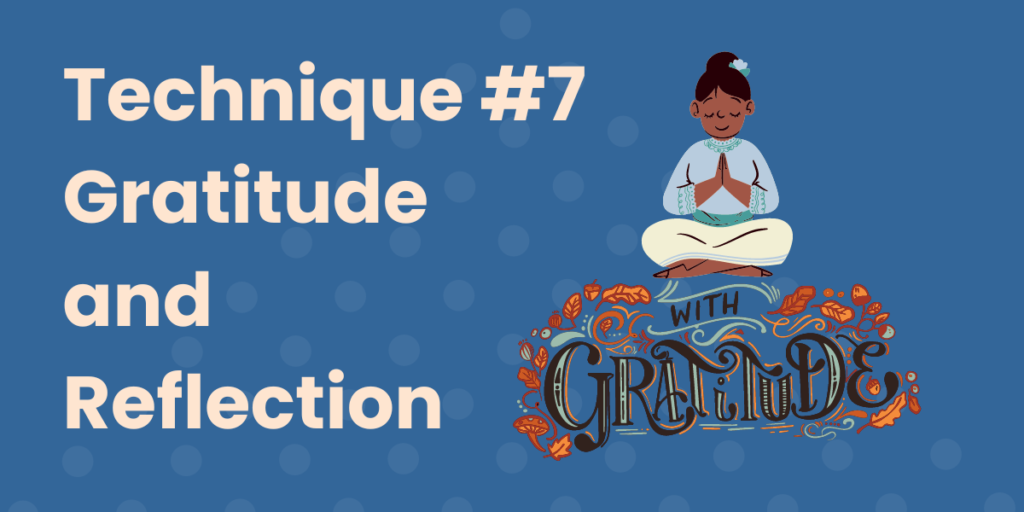
Technique #7: Gratitude and Reflection – The Mindful Eating Journal
I was raised in a Catholic home. So we prayed to give thanks when the family came together for dinner.
So I always wondered, should I not give thanks to my parents? They’re the ones who worked hard to make sure I’m fed.
Well… yes, I should.
Whatever your relationship with the Divine, with people in your life, and with yourself, expressing gratitude is the greatest life-hack.
So how do we continue our journey of greater alignment through gratitude?
Benefits of keeping a mindful eating journal
A journal is a great way!
Clinicians often tell patients to keep logs. Blood pressure logs, blood sugar logs, weight logs.
Diet programs seem to tell clients to keep food logs, calorie logs, and weight logs.
It’s all very important and objectively tells us how you’ve been doing.
But… What about gratitude logs? Can you keep track of your level of appreciation? How about satisfaction on a scale of 1 to 10?
In my opinion, keeping a mindful eating journal is not about improving nutrition by tracking calories or other objective parameters.
This type of journal is about enhancing nourishment of the soul. It’s about developing awareness of how a particular food can nourish the body AND the soul.
So how can we practice a method of eating that supports us holistically?
How to practice food gratitude
“Let us give thanks”.
Every Christian household knows this quick prayer.
We simply give thanks, “for the bounty we are about to receive”.
Giving thanks is not an exclusively Christian concept. Giving thanks spans cultures and religions around the world and throughout history!
The point is this: You do not need a “How to…” guide. You don’t even need words to form a prayer. You only need to invoke the feeling of gratitude for the meal you will receive.
Words will help direct your feelings. I imagine words like training wheels or guide rails. Words give direction while feeling gives them substance.
So if we want to follow a guide, what should we consider?
Reflective questions for before and after meals
Before a meal:
- How do you feel?
- Tell me about your day so far.
- How has that led you to feel this way?
- Is that something you want to bring to the table?
- Why is that important to you?
- Does this help you align with your values?
After a meal:
- How do you feel?
- Tell me how that’s different from before the meal.
- Tell me what has changed.
- Do you feel light and energetic?
- Why is that important to you?
- How does that align with your values?
Using journaling to identify patterns and progress
Again, people often use journaling to objectively measure different parameters. Again, they are important.
However, try identifying patterns that detract or enhance gratitude.
For example:
- 8/9/2024
- Before breakfast: Gratitude 8/10. Energy 7/10. Feeling groggy.
- After breakfast: Gratitude 9/10. Energy 8/10. Feeling more awake.
- Before lunch: Gratitude 9/10. Energy 6/10. Feeling tired.
- After lunch: Gratitude 8/10. Energy 8/10. Feeling good.
- Before dinner: Gratitude 6/10. Energy 7/10. Feeling excited.
- After dinner: Gratitude 7/10. Energy 8/10. Feeling well.
This is just one day. Create a spreadsheet and you will start to identify a pattern.
Maybe Monday’s are just, “not your day”; or maybe something is happening every Sunday that leads to a less fulfilling Monday.
Your food can nourish your body and your soul. So experiment and see how different foods impact your appreciation and energy levels.
Conclusion – Mindful Eating Techniques:
Congratulations! You’ve just unlocked the secrets to transforming your relationship with food through mindful eating techniques. Remember, this journey is about progress, not perfection.
Start small, be compassionate with yourself, and watch as these techniques ripple through your life, creating a more balanced and joyful approach to eating.
Why not start right now?
Take a deep breath, choose one technique, and savor your next meal!
References
- Food For Thought: The Subtle Forces That Affect Your Appetite. (2016, May 31). NPR. https://www.npr.org/transcripts/479754700
- Matsuhisa, T., Fujie, R., Masukawa, R., Nakamura, N., Mori, N., Ito, K., Yoshikawa, Y., Okazaki, K., & Sato, J. (2024). Impact of a Mindfulness Mobile Application on Weight Loss and Eating Behavior in People with Metabolic Syndrome: a Pilot Randomized Controlled Trial. International journal of behavioral medicine, 31(2), 202–214. https://doi.org/10.1007/s12529-023-10173-2

